2020-06-25 - Nº 269
Editorial
Esta é a Newsletter Nº 269 que se apresenta com o mesmo formato que as anteriores. Se gostar da Newsletter partilhe-a!
Todas as Newsletters encontram-se indexadas no link.
Esta Newsletter tem os seguintes tópicos:
Faz hoje anos que nascia, em 1864, o físico alemão Walther Nernst. Ele foi um dos fundadores da química moderna. Em 1889, ele desenvolveu a sua teoria do potencial eléctrico e condução de soluções electrolíticas (a Equação de Nernst) e introduziu o produto de solubilidade para explicar as reacções de precipitação. Em 1906, Nernst mostrou que é possível determinar a constante de equilíbrio para uma reacção química a partir de dados térmicos e, ao fazê-lo, formulou o que ele próprio chamava de terceira lei da termodinâmica. Isto afirma que a entropia (uma medida termodinâmica de desordem em um sistema) aproxima-se de zero à medida que a temperatura vai em direcção ao zero absoluto. Por isto, ele recebeu o Prémio Nobel de 1920 em Química. Em 1918, ele explicou a explosão do H2-Cl2 na exposição à luz como uma reacção em cadeia do átomo.
Faz também hoje anos que nascia, em 1894, o cientista alemão Hermann Oberth. Ele era um dos três fundadores do voo espacial (com Tsiolkovsky e Goddard). Após uma lesão na Primeira Guerra Mundial, ele elaborou uma proposta para um foguete de longo alcance, propulsor líquido, que o Ministério da Guerra considerou fantasioso. Até a dissertação sobre o seu projecto de foguete foi rejeitada pela Universidade de Heidelberg. Quando o publicou como Die Rakete zu den Planetenräumen (1923; "O foguete para o espaço interplanetário"), ele ganhou reconhecimento pela sua análise matemática da velocidade do foguete que lhe permitiria escapar da atracção gravitacional da Terra. Ele recebeu uma patente romena em 1931 por um projecto de foguete com propulsor líquido. O seu primeiro foguete foi lançado em 7 de maio de 1931, perto de Berlim.
Por fim, faz hoje anos que nascia, em 1907, o físico alemão J. Hans D. Jensen. Ele propôs a teoria da estrutura nuclear dos núcleos - protões e neutrões - agrupados em camadas semelhantes a cebolas de conchas concêntricas. Ele sugeriu que os núcleos giravam em seu próprio eixo enquanto se moviam numa órbita dentro da concha e que certos padrões no número de núcleos por concha tornavam o núcleo mais estável. Os cientistas já sabiam que os electrões que orbitam o núcleo estavam dispostos em diferentes camadas. Pelo seu modelo do núcleo, Jensen partilhou o Prémio Nobel de 1963 em física (com Maria Goeppert-Mayer, que chegou à mesma hipótese de forma independente nos EUA; e Eugene P. Wigner, por trabalhos não relacionados.) Nos anos 50, Jensen trabalhou em radioactividade.
Nesta semana que passou foi anunciado o supercomputador Japonês Fugaku, que está a ser desenvolvido em conjunto pela RIKEN e Fujitsu Limited, ocupou o primeiro lugar na lista Top500, um ranking dos supercomputadores mais rápidos do mundo. Ele também limpou os outros rankings de desempenho de supercomputadores, ocupando o primeiro lugar no HPCG, um ranking de supercomputadores executando aplicações do mundo real, o HPL-AI, que classifica os supercomputadores com base nos seus recursos de desempenho para tarefas tipicamente usadas em aplicativos de inteligência artificial e Graph 500, que classifica os sistemas com base em cargas com uso intenso de dados. É a primeira vez na história que o mesmo supercomputador se torna o número 1 no Top500, HPCG e Graph500 simultaneamente. Este supercomputador é baseado em tecnologia ARM A64FX com 48 Cores a 2.2 GHz da Fujitsu e tem 7.299.072 CPU cores. Em termos de capacidade de processamento tem 415 Petaflops podendo atingir um máximo de 513 PetaFlops e tem disponível 4.87PB de RAM. Para funcionar consome uns estrondosos 28MW de energia. Ele usa o sistema operativo Red Hat Enterprise Linux. Por comparação com o anterior primeiro colocado - o Summit da IBM - este tinha "apenas" 148-PFLOPS de capacidade de calculo e consumia "apenas" 10MW.
Na Newsletter desta semana apresentamos diversas noticias, artigos científicos assim como projetos de maker. São apresentadas as revistas MagPI Nº 95 de Julho e newselectronics de 23 de Junho.
 João Alves ([email protected])
João Alves ([email protected])
O conteúdo da Newsletter encontra-se sob a licença  Creative Commons Attribution-NonCommercial-ShareAlike 4.0 International License.
Creative Commons Attribution-NonCommercial-ShareAlike 4.0 International License.
Novidades da Semana
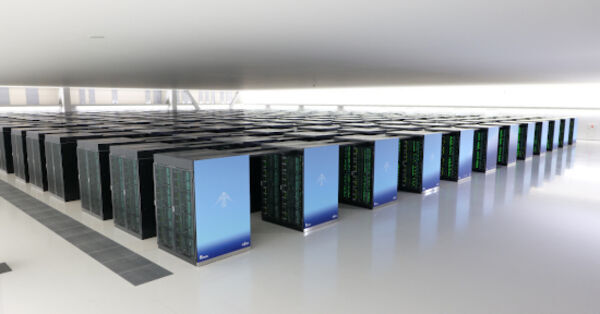
Japan’s Fugaku gains title as world’s fastest supercomputer
"The supercomputer Fugaku, which is being developed jointly by RIKEN and Fujitsu Limited based on Arm® technology, has taken the top spot on the Top500 list, a ranking of the world’s fastest supercomputers. It also swept the other rankings of supercomputer performance, taking first place on the HPCG, a ranking of supercomputers running real-world applications, HPL-AI, which ranks supercomputers based on their performance capabilities for tasks typically used in artificial intelligence applications, and Graph 500, which ranks systems based on data-intensive loads. This is the first time in history that the same supercomputer has become No.1 on Top500, HPCG, and Graph500 simultaneously. The awards were announced on June 22 at the ISC High Performance 2020 Digital, an international high-performance computing conference. On the Top500, it achieved a LINPACK score of 415.53 petaflops, a much higher score than the 148.6 petaflops of its nearest competitor, Summit in the United States, using 152,064 of its eventual 158,976 nodes. This marks the first time a Japanese system has taken the top ranking since June 2011, when the K computer—Fugaku’s predecessor—took first place." [...]

China's GPS rival Beidou is now fully operational after final satellite launched
"China launched the last satellite in its Beidou navigation network on Tuesday, completing a new rival to GPS and cementing its place in an elite group of countries with their own global navigation satellite systems (GNSS). To date, there are only four major GNSS networks: GPS (US), GLONASS (Russia), Galileo (European Union) and now Beidou. India and Japan operate smaller systems. Most people are familiar with GPS, which is used for everything from personal navigation on your smartphone to tracking planes and container ships around the world. Beidou is China's alternative system. It's named after the Chinese word for the Big Dipper constellation, and has taken almost two decades to complete." [...]
Outras Notícias

Virgin Galactic's SpaceShipTwo Completes Second Flight from Spaceport America
"Virgin Galactic Holdings, Inc. (NYSE: SPCE) (“Virgin Galactic” or “the Company”) today announced the successful completion of the second SpaceShipTwo test flight from Spaceport America. This flight follows the completion of the first test flight from the Company’s commercial headquarters in New Mexico on May 1, 2020, and marks another important milestone as the team progresses toward the launch of Virgin Galactic’s commercial service. On SpaceShipTwo Unity’s flight deck were Mark ‘Forger’ Stucky and Michael ‘Sooch’ Masucci. Both pilots are commercial astronauts, having each previously flown Unity into space on different flights. Piloting the Company’s carrier aircraft, VMS Eve, were Nicola Pecile and CJ Sturckow. This glide flight, flown at higher speeds, allowed the team to continue to evaluate systems and vehicle performance in advance of future rocket-powered space flights from the Company’s new operating base in New Mexico." [...]
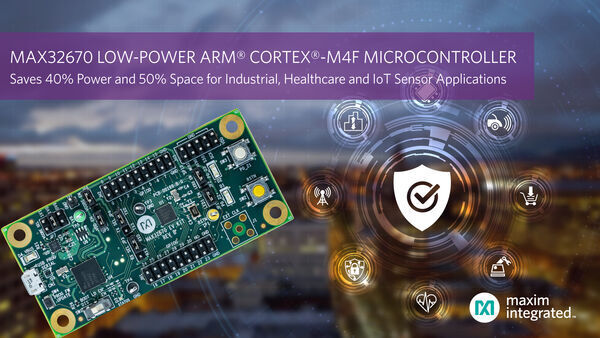
Ultra-Reliable Arm Cortex-M4F Microcontroller from Maxim Integrated Offers Industry’s Lowest Power Consumption and Smallest Size for Industrial, Healthcare and IoT Sensor Applications
"Reduce power consumption and size while increasing reliability of industrial, healthcare and internet of things (IoT) applications with the MAX32670 low-power Arm® Cortex®-M4 microcontroller (MCU) with floating-point unit from Maxim Integrated Products, Inc. (NASDAQ: MXIM). This device protects all embedded memory for both flash and SRAM with error-code correction (ECC) in order to provide the highest reliability MCU. For details about Maxim Integrated’s low-power microcontroller solutions › To order MAX32670 or learn more › For a hi-res image › In many industrial and IoT applications, high energy particles and other environmental challenges present the danger of bombarding memory and creating bit flips during the normal course of operations – especially as process nodes drop to 40nm and lower. This can disrupt MCU operation and produce incorrect or even dangerous results. To prevent catastrophic ramifications like these, the MAX32670 protects its entire memory footprint (384kB flash and 128kB SRAM) with ECC to prevent bit flips and enhance reliability. With ECC, single-bit errors are detected and corrected by hardware, making it difficult for bit flip errors to have a negative impact on the application." [...]

NASA’s TESS, Spitzer Missions Discover a World Orbiting a Unique Young Star
"The system, known as AU Mic for short, provides a one-of-a-kind laboratory for studying how planets and their atmospheres form, evolve and interact with their stars. “AU Mic is a young, nearby M dwarf star. It’s surrounded by a vast debris disk in which moving clumps of dust have been tracked, and now, thanks to TESS and Spitzer, it has a planet with a direct size measurement,” said Bryson Cale, a doctoral student at George Mason University in Fairfax, Virginia. “There is no other known system that checks all of these important boxes.” The new planet, AU Mic b, is described in a paper co-authored by Cale and led by his advisor Peter Plavchan, an assistant professor of physics and astronomy at George Mason. Their report was published on Wednesday, June 24, in the journal Nature. AU Mic b is featured in a new NASA poster available in English and Spanish, part of a Galaxy of Horrors series." [...]
Ciência e Tecnologia

Physicists Publish Worldwide Consensus of Muon Magnetic Moment Calculation
"For decades, scientists studying the muon have been puzzled by a strange pattern in the way muons rotate in magnetic fields, one that left physicists wondering if it can be explained by the Standard Model — the best tool physicists have to understand the universe. This week, an international team of more than 170 physicists published the most reliable prediction so far for the theoretical value of the muon’s anomalous magnetic moment, which would account for its particular rotation, or precession. The magnetic moment of subatomic particles is generally expressed in terms of the dimensionless Landé factor, called g. While a number of international groups have worked separately on the calculation, this publication marks the first time the global theoretical physics community has come together to publish a consensus value for the muon’s magnetic moment. The result differs from the most recent experimental measurement, which was performed at Brookhaven National Laboratory in 2004, but not significantly enough to unambiguously answer this question. Now the world awaits the result from Fermilab’s current Muon g-2 experiment. In the upcoming months, physicists working on the experiment will unveil their preliminary measurement for the value." [...]
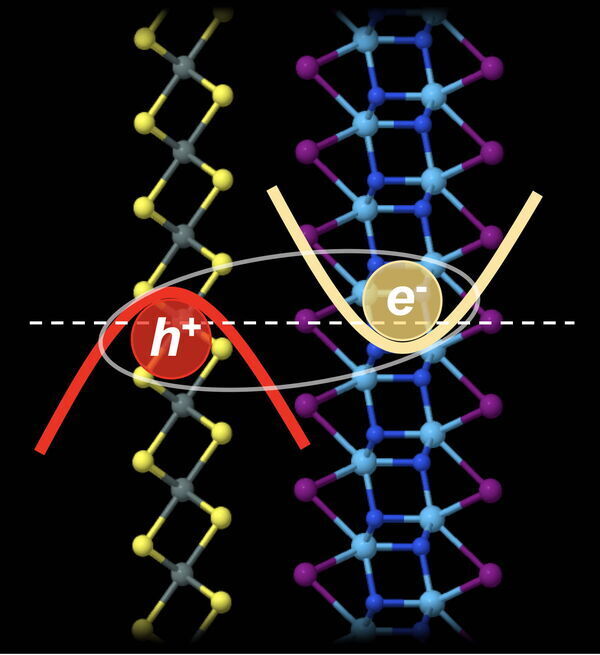
Excitons form superfluid in certain 2D combos
"Mixing and matching computational models of 2D materials led scientists at Rice University to the realization that excitons — quasiparticles that exist when electrons and holes briefly bind — can be manipulated in new and useful ways. The researchers identified a small set of 2D compounds with similar atomic lattice dimensions that, when placed together, would allow excitons to form spontaneously. Generally, excitons happen when energy from light or electricity boosts electrons and holes into a higher state. But in a few of the combinations predicted by Rice materials theorist Boris Yakobson and his team, excitons were observed stabilizing at the materials’ ground state. According to their determination, these excitons at their lowest energy state could condense into a superfluidlike phase. The discovery shows promise for electronic, spintronic and quantum computing applications." [...]
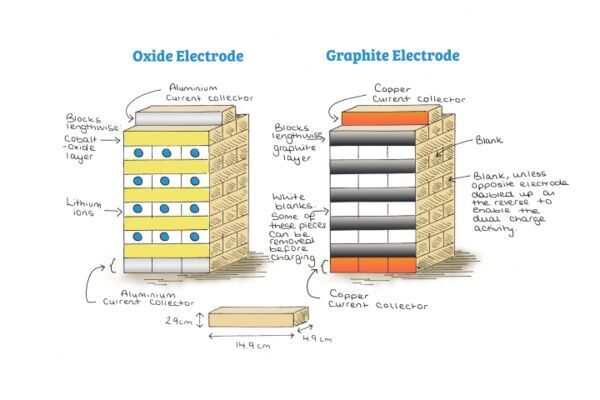
Using Jenga to explain lithium-ion batteries
"Tower block games such as Jenga can be used to explain to schoolchildren how lithium-ion batteries work, meeting an educational need to better understand a power source that has become vital to everyday life. While lithium-ion batteries are abundant in so many of our electronic devices, from smart phones to electric vehicles, the resources available to teach children how they work and why they are important are limited. A team in the University of Birmingham’s School of Chemistry, has devised an educational tool which uses the tower block game Jenga to explain the processes at work inside the battery cells and the electrochemistry behind them. Their method is published in the Journal of Chemical Education. A rechargeable Li-ion battery consists of an oxide and a graphite electrode. These are commonly built in layers separated with an electrolyte." [...]

A salt solution toward better bioelectronics
"A water-stable dopant enhances and stabilizes the performance of electron-transporting organic electrochemical transistors. Doping is commonly used to improve performance in semiconducting devices but has not previously been successful for electron transporting or n-type, organic electronic materials. Now, an approach developed by KAUST uses a dopant, an additive that boosts the electronic performance and water stability of an n-type semiconducting polymer, to produce the first water-stable n-doped, organic electrochemical transistors, known as OECTs. Organic electrochemical transistors comprise plastic-mixed conductors—active semiconductor layers that conduct ionic and electronic charges at the same time. These mixed conductors allow OECTs to convert ionic signals in electrolytes and biological fluids into electronic signals. However, the performance of n-type organic semiconductors lags behind that of their hole-transporting counterparts in environments dictated by biological systems, which is a major obstacle to developing logic circuits and transistor arrays." [...]

Newly observed phenomenon could lead to new quantum devices
"Exotic states called Kohn anomalies could offer clues to why some materials have the electronic properties they do. An exotic physical phenomenon known as a Kohn anomaly has been found for the first time in an unexpected type of material by researchers at MIT and elsewhere. They say the finding could provide new insights into certain fundamental processes that help determine why metals and other materials display the complex electronic properties that underlie much of today’s technology. The way electrons interact with phonons — which are essentially vibrations passing through a crystalline material — determines the physical processes that take place inside many electronic devices. These interactions affect the way metals resist electric current, the temperature at which some materials suddenly become superconductors, and the very low temperature requirements for quantum computers, among many other processes. But electron-phonon interactions have been difficult to study in detail because they are generally very weak." [...]

A new spin on low-power data storage
"Device controlled solely by voltage paves the way for spintronics with ultralow power consumption. An improved ability to control the magnetization of electrodes made at KAUST from ferromagnets could help develop more energy-efficient devices for spintronic applications, including data storage technologies, wearable electronics and implantable medical devices. Fueled by the demand for information storage technologies with increased capacity, miniature devices called magnetic tunnel junctions (MTJs) have emerged as a promising way to store large amounts of data. MTJs consist of tiny ferromagnets separated by an ultrathin insulating layer. Their electrical resistance can be switched between low and high states—corresponding with the binary bits 0 and 1—and so can be used to store information in magnetoresistive random access memory and other spintronic devices. Traditionally, this switching has used a magnetic field, a spin-orbit torque or a spin-transfer torque, which applies a high electric current density to the device that then dissipates large amounts of energy." [...]
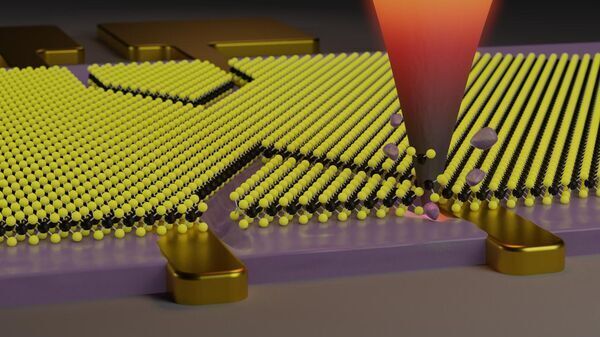
Researchers cut nanometer-sized patterns into 2D materials
"EPFL researchers have developed a high-precision technology that enables them to carve nanometric patterns into two-dimensional materials. With their pioneering nanotechnology, EPFL researchers have achieved the impossible. They can now use heat to break the links between atoms with a miniature scalpel. “It’s extremely hard to structure 2D materials using conventional lithography, which often employs aggressive chemicals or accelerated, electrically charged particles, like electrons or ions, that can damage the material’s properties,” says Xia Liu, a researcher and postdoc in the School of Engineering’s Microsystems Laboratory. “Our technique, however, uses a localized heat and pressure ‘source’ to accurately cut into the 2D materials.” “Our technology is similar to the art of paper-cutting, which is common in this region of Switzerland, but on a much smaller scale,” explains Ana Conde Rubio, co-author of the study. “We use heat to modify the substrate and make it more flexible and, in some cases, even turn it into a gas." [...]
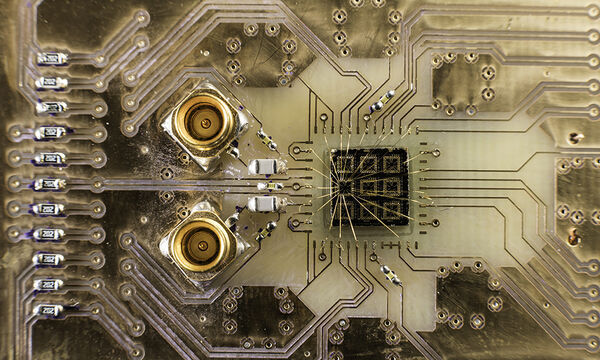
Is teleportation possible? Yes, in the quantum world
"Beam me up” is one of the most famous catchphrases from the Star Trek series. It is the command issued when a character wishes to teleport from a remote location back to the Starship Enterprise. While human teleportation exists only in science fiction, teleportation is possible in the subatomic world of quantum mechanics—albeit not in the way typically depicted on TV. In the quantum world, teleportation involves the transportation of information, rather than the transportation of matter. Last year scientists confirmed that information could be passed between photons on computer chips even when the photons were not physically linked. Now, according to new research from the University of Rochester and Purdue University, teleportation may also be possible between electrons." [...]
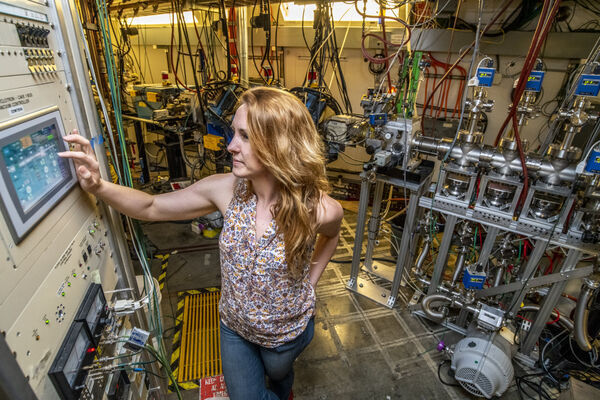
Introducing a New Isotope: Mendelevium-244
"Berkeley Lab-led team creates a new, lighter form of the element mendelevium in experiments at the 88-Inch Cyclotron A team of scientists working at Lawrence Berkeley National Laboratory (Berkeley Lab) has discovered a new form of the human-made element mendelevium. The newly created isotope, mendelevium-244, is the 17th and lightest form of mendelevium, which is element 101 on the periodic table. Mendelevium was first created by Berkeley Lab scientists in 1955 (see a related video), and is among a list of 16 elements that Berkeley Lab scientists discovered or helped to discover. An isotope is a form of an element with more or fewer neutrons (uncharged particles) in its atomic nucleus than other forms of an element. In the latest discovery, the team used Berkeley Lab’s 88-Inch Cyclotron, which accelerates powerful beams of charged particles at targets to create atoms of heavier elements, to make mendelevium-244. A cyclotron is a type of particle accelerator that was invented by the Lab’s namesake, Ernest O. Lawrence, in 1930." [...]

Engineers design a device that operates like a brain synapse
"Ion-based technology may enable energy-efficient simulations of the brain’s learning process, for neural network AI systems. Teams around the world are building ever more sophisticated artificial intelligence systems of a type called neural networks, designed in some ways to mimic the wiring of the brain, for carrying out tasks such as computer vision and natural language processing. Using state-of-the-art semiconductor circuits to simulate neural networks requires large amounts of memory and high power consumption. Now, an MIT team has made strides toward an alternative system, which uses physical, analog devices that can much more efficiently mimic brain processes. The findings are described in the journal Nature Communications, in a paper by MIT professors Bilge Yildiz, Ju Li, and Jesús del Alamo, and nine others at MIT and Brookhaven National Laboratory. The first author of the paper is Xiahui Yao, a former MIT postdoc now working on energy storage at GRU Energy Lab." [...]
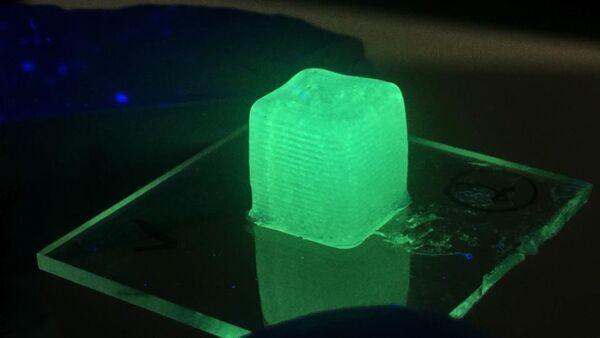
New Technique Allows 3D Printing of Flexible Materials
"Engineers at the University of California, Davis, have developed a new approach to 3D printing that allows printing of finely tuned flexible materials. By using a droplet-based, multiphase microfluidic system, the team was able to efficiently print materials with potential applications in soft robotics, tissue engineering and wearable technology. The work is published June 15 in the Proceedings of the National Academy of Sciences. In traditional extrusion-based 3D printers, printing material is pushed through a nozzle and added to the structure repeatedly until the product is complete. While this is efficient and cost-effective, it makes it hard to print structures made of more than one material, and getting the right amount of softness can be challenging. Jiandi Wan, assistant professor of chemical engineering at UC Davis, noticed that this nozzle was similar to the glass capillary microfluidic devices that his lab studies." [...]

A new material for light-matter interactions
"EPFL scientists have coupled a new material with light at the level of a single photon. The achievement opens up prospects for better controlling and understanding the properties of quantum-correlated systems, where theoretical calculations are difficult. There is a large group of materials that physicists refer to as “strongly correlated”, which include insulators and electronic materials that have unusual electronic and magnetic properties, or even neutrons in neutron stars. Their properties result from the fact that their constituents interact very strongly with each other: new features appear at the collective level, that are not present in isolated particles. The unique properties of strongly correlated materials are often technologically useful, and are thus used in superconducting magnets and magnetic storage technology, but also in the emerging ‘quantum technologies’. Now, scientists led by Jean-Philippe Brantut at EPFL’s Institute of Physics, have discovered the first complex, strongly correlated material whose constituents are strongly coupled to light at the single-photon level." [...]

Synthetic materials mimic living creatures
"Northwestern University researchers have developed a family of soft materials that imitates living creatures. When hit with light, the film-thin materials come alive — bending, rotating and even crawling on surfaces. Called “robotic soft matter" by the Northwestern team, the materials move without complex hardware, hydraulics or electricity. The researchers believe the lifelike materials could carry out many tasks, with potential applications in energy, environmental remediation and advanced medicine. “We live in an era in which increasingly smarter devices are constantly being developed to help us manage our everyday lives,” said Northwestern’s Samuel I. Stupp, who led the experimental studies. “The next frontier is in the development of new science that will bring inert materials to life for our benefit — by designing them to acquire capabilities of living creatures.” The research was published today (June 22) in the journal Nature Materials." [...]

Ion Conducting Polymer Crucial to Improving Neuromorphic Devices
""Neuromorphic" refers to mimicking the behavior of brain neural cells. When one speaks of neuromorphic computers, they are talking about making computers think and process more like human brains-operating at high-speed with low energy consumption. Despite a growing interest in polymer-based neuromorphic devices, researchers have yet to establish an effective method for controlling the response speed of devices. Researchers from Tohoku University and the University of Cambridge, however, have overcome this obstacle through mixing the polymers PSS-Na and PEDOT:PSS, discovering that adding an ion conducting polymer enhances neuromorphic device response time. Polymers are materials composed of long molecular chains and play a fundamental aspect in modern life from the rubber in tires, to water bottles, to polystyrene. Mixing polymers together results in the creation of new materials with their own distinct physical properties." [...]
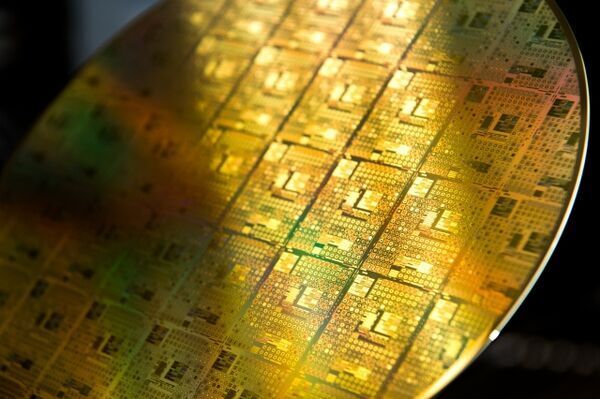
Lincoln Lab transfers integrated circuit process to industry
"Fabrication technique will enable SkyWater Technology to manufacture a range of electronics that can withstand harsh radiation environments. High levels of radiation, such as those occurring naturally in space and at high altitudes on Earth, can wreak havoc on electronics. MIT's Lincoln Laboratory has developed a unique process for making integrated circuits resistant to damage and malfunction caused by extreme radiation levels. This fabrication capability — the 90-nanometer fully depleted silicon-on-insulator (FDSOI) complementary metal-oxide-semiconductor (CMOS) process — is now being transferred to microchip manufacturer SkyWater Technology, which will use it to produce radiation-hardened, or rad-hard, electronics. “Our 90-nanometer FDSOI CMOS process has matured and scaled, and it has reached a level of interest for those who need integrated circuits that are exposed to extreme radiation environments,” says Pascale Gouker, a senior staff member at Lincoln Laboratory who has worked on this technology for more than two decades. “There are many applications in space, high-energy physics, and other national security-related areas that operate in extreme environments and need to be 'rad-hard." [...]
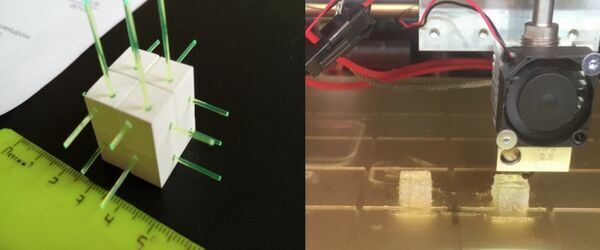
A CERN-led international collaboration develops 3D-printed neutrino detectors
"A 3D-printed “super-cube” scintillator would be the first occurrence of additive manufacturing being used in particle detectors and would allow more precise data collection Plastic scintillators are one of the most used active materials in high-energy physics. Their properties make it possible to track and distinguish between particle topologies. Among other things, scintillators are used in the detectors of neutrino oscillation experiments, where they reconstruct the final state of the neutrino interaction. Measurements of oscillation phenomena are carried out through comparison of observations of neutrinos in near detectors (close to the target) and far detectors (up to several hundred kilometres away). CERN is strongly involved in the T2K experiment, the current world-leading neutrino oscillation experiment, in Japan, which recently released promising results. A future upgrade of the experiment’s near detector will pave the way for more precise results." [...]
Documentação
A documentação é parte essencial do processo de aprendizagem e a Internet além de artigos interessantes de explorar também tem alguma documentação em formato PDF interessante de ler. Todos os links aqui apresentados são para conteúdo disponibilizado livremente pelo editor do livro.
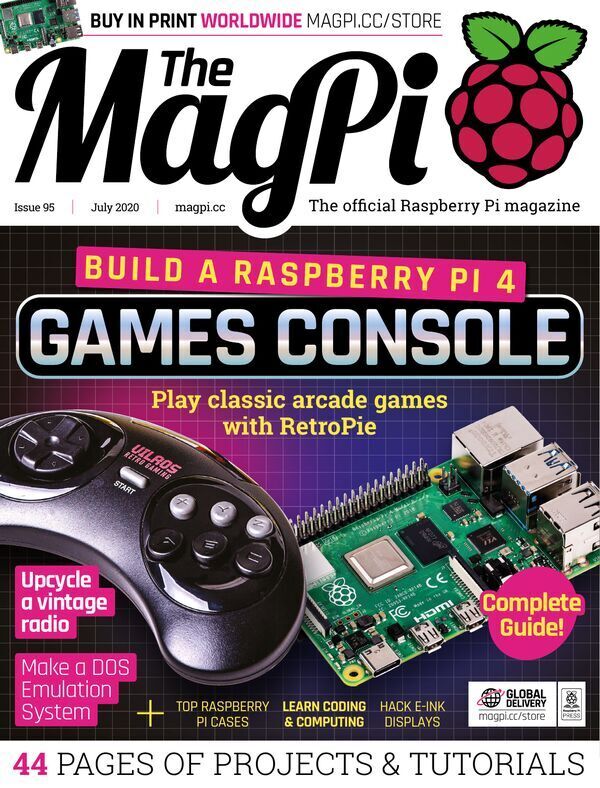
The MagPI 95
"Inside The MagPi magazine #95 Build a Raspberry Pi 4 games console. We’ve got the best cases, awesome controllers, and easy to use kit. Also a step-by-step guide to setting up RetroPie OS with Raspberry Pi 4, so you can run classic games. Plus! How to get games legally. Learn Computing & ICT at home." [...]

newelectronics 23 Junho 2020
"New Electronics is a fortnightly magazine focusing on technological innovation, news and the latest developments in the electronics sector. Downloadable as a digital page turner or pdf file, or offered as a hard copy, the New Electronics magazine is available in a format to suit you. " [...]
Projetos Maker
Diversos Projetos interessantes.

Rotary Musical Phone
"I hacked a rotary phone into a radio! Pick up the phone, choose a country and a decade, and listen to some great music! How it works This rotary phone has a microcomputer built-in (a Raspberry Pi), that communicates to radiooooo.com, a web radio. There is a microcontroller (an Arduino) behind the map that controls the selection of the country. Together, this makes for an awesome, IoT project! " [...]

5x5x5 RGB Color Cube
"An easy to construct RGB cube with a fantastic light show in software. This is one of a series of instructions on building LED cubes with the MEGA. The overall purpose is to build cubes without a lot of external hardware. They're typically hard to build because they require lots of shift registers, numerous ICs mounted on a PC board. We are trying to keep things simple and able to be hand wired. The first of these projects was a 5x5xx5 blue LED cube (single color)." [...]
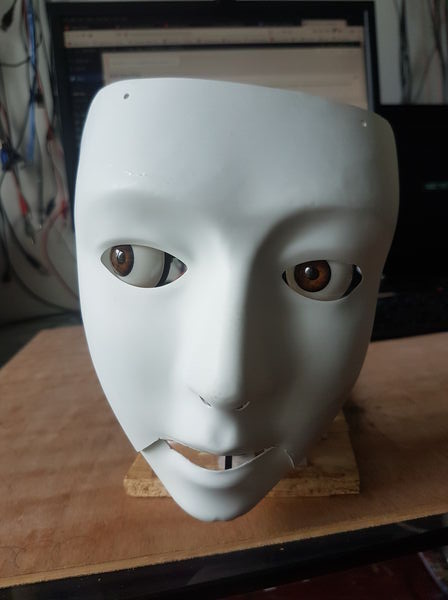
Spooky Alexa mask
"This is the animatronic mask made by Keith Colton for the 2019 Dublin Maker Faire. This post will document the assembly and the current electronics being used. All images can be clicked on to view the full resolution image. " [...]
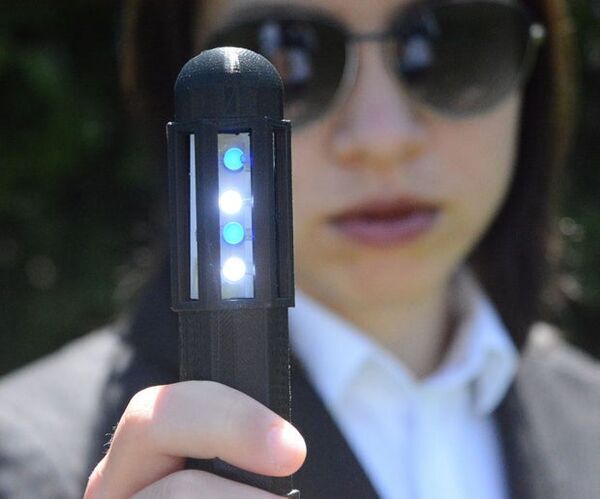
DIY Neuralyzer and Men in Black Costume
"If you have a couple of hours to spare during quarantine, this DIY Neuralyzer can be a fun introductory project into the world of electronics and 3D printing. As a plus, it can make a family member or friend laugh as they see you parading around in a Men in Black costume! First, I'll explain how to make the Neuralyzer, then the costume. Supplies: For the Neuralyzer, you will need: 1. 3V coin cell battery 2. 4 LEDs (I used 2 blue ones and 2 white ones) 3." [...]

HDSP clock with SCD5583 display
"Here is another interesting "intelligent" LED matrix display, whose name actually makes some sense (unlike HDSP-2354, among many others): SCD5583A. I reckon it means: "Serial Character Display with 5x5x8 dot matrix". 3 is the code for green (0 for red, 1 for yellow). This display is now obsolete (replaced by touch screens in avionics, the industry for which it was designed), but it is still available on ebay for a reasonable price (except for incredibly high shipping cost). Compared to other intelligent displays like the above-mentioned HDSP-2534 employed by the HDSP clock (hence the bland unimaginative name), SCD558X does not have an internally-defined font and requires the user to provide one. This makes it a little more complicated to use, but also allows for more flexibility, making it truly international (non-English character set)." [...]
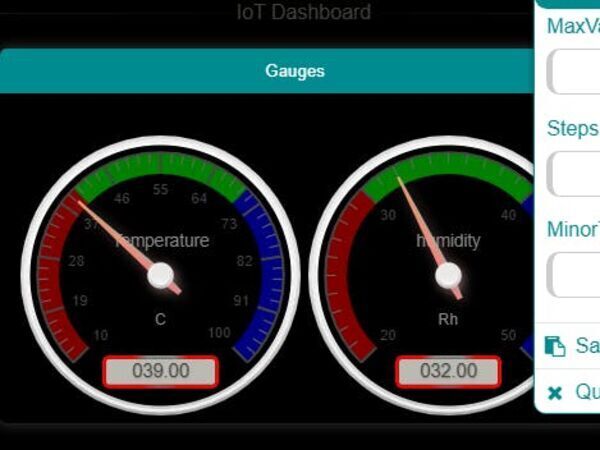
IoT - Eggs Incubator
"IoT - Eggs incubtor over the internet, with data collection using CavyIoT service Eggs Incubation is an interesting topic among the Arduino enthusiastic. Basically, it is similar to the type of incubator which can be used as a substitute of poultry chicken to incubate the chicken eggs automatically. It will be helpful for the farmers to incubate the eggs automatically without the need of human intervention, by keeping the physical quantities such as temperature and humidity at required level, so that the fetuses inside them will grow and incubates without the presence of mother. Furthermore, egg incubator will not only improve the poultry production considerably but will also help in the regularity of income making, enabling the farmers to be able to get transition into possible rural entrepreneurship. This project uses a CavyIoT-DevBoard (firmware) and CavyIoT platform as a service.. With the help of Control Panel from anywhere we can Monitor live sensor data in Charts, Gauges. Control all operations of incubator." [...]

Visualize sorting algorithms with Arduino and LED strip
"Feel confused about sorting algorithms? Use LEDs and Arduino to get better understanding about them! Sorting algorithms are the basic algorithms for beginners who want to learn computer science or programming. But sometimes you will get confused about how these algorithms work. Thus, there are plenty of visualizations of these sorting algorithms for beginners. But there are no visualization methods based on LEDs." [...]

Smartglove for Cyclists
"In this instructable, I will detail how I made this "smartglove" and its LED panel so that cyclists or other road users can ride/drive safer. How it works: The glove is made with an Arduino board that collects data from a gyroscope and an accelerometer. The Arduino code uses a model of tiny machine learning (tinyML), and it works with gesture recognition: each hand movement is analyzed and recognized (hand tilted to the left, right, front, back, etc.). Then this signal is sent through Bluetooth (BLE) to another microcontroller connected to an LED matrix (placed on a backpack, for example). According to the signal received by the microcontroller, some patterns light up on the LED matrix, so that other road users can see what the cyclist is doing (as an example right, left and straight arrows, or also text). Origins of the project: This is what motivated me to make this project: First, I go to work by bike, and I ride more than 1 hour every day (approximately 22 km)." [...]
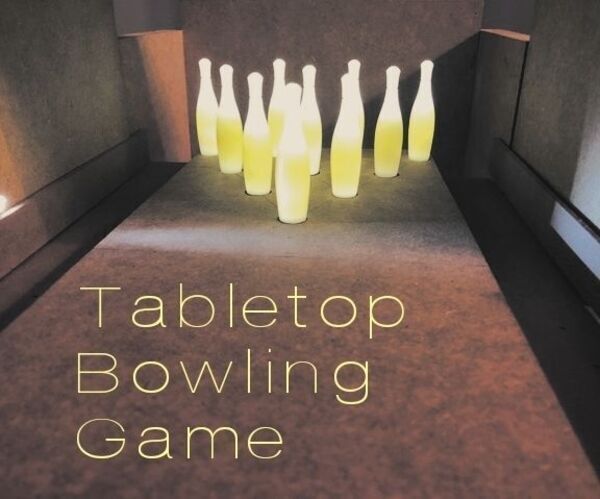
Tabletop Bowling Game
"Looking for a fun way to bowl at home? This instructable walks you through how to make a completely functional tabletop bowling game. Developed by an avid bowler for a school project, this Arduino-controlled at-home bowling game brings the bowling alley right to your house! The game works by hooking up photoresistors to sense lights mounted under each pin to tell the game whether or not the pins have been knocked over, which allows the game to keep an accurate score through all ten frames. And as a bonus, the LEDs light up the pins to give them a glowing effect - so turn on your black light and have your own cosmic bowling party! Supplies: Structural 3/4" wood, plywood, or MDF (at least 5.5 feet long) 1/8" plywood or MDF (at least 5 feet long) 1" x 3" lumber (pine was used for this project) Electronics 1 Arduino Uno 2 standard size breadboards 11 white LEDs 11 photo-resistors 11 10k Ohm resistors 1 4-pin I2C LCD display ~ 70-75 jumper wires (This can vary slightly depending on exactly how close wires are to the breadboard and where you place your Arduinos." [...]
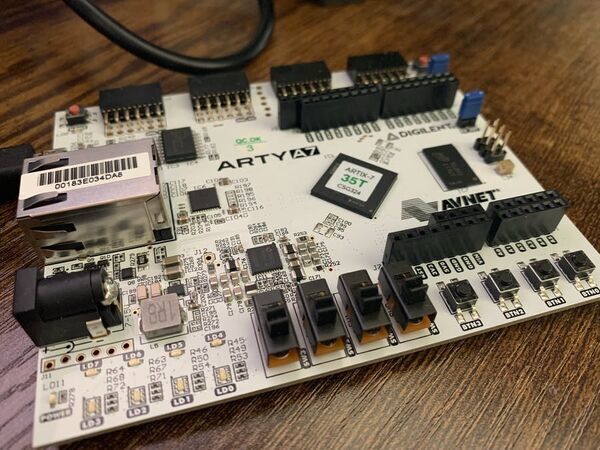
Hello MicroBlaze on Arty-A7
"See how to bring up Xilinx's soft-processor implementation, the MicroBlaze, on the Arty-A7 board. The Arty A7 board is a development board for Xilinx's Artix-7 FPGA chip. It comes in two sizes in terms of the amount of programmable logic available in the FPGA: the Arty A7-35T and the Arty A7-100T. It is also one of the more affordable options for FPGA development boards with the Arty A7-35T available for $129. " [...]
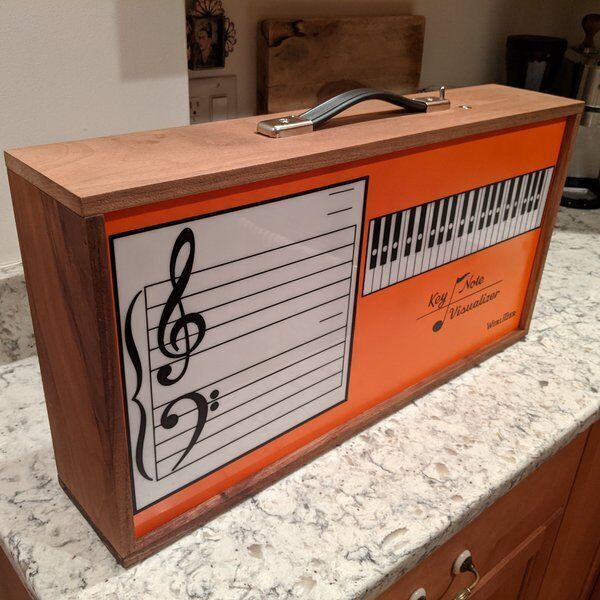
Wurlitzer Key Note Visualizer Replica
"Miniature, portable build of Wurlitzer's elusive keyboard teaching tool. I am building a replica of Wurlirtzer's Key Note Visualizer. It's a simple and beautiful concept: play notes on a keyboard, and watch them light up on the display. There isn't much info out there about this device, but I gather that it was originally designed as a tool for piano teachers to show a class of students what they were playing in real time. It's unclear how the original visualizer connected to the Wurlitzer keyboards, but my build will work with any MIDI-enabled device. It will be battery powered and will communicate via Bluetooth, making it completely wireless." [...]

Arduino Controlled Robotic Biped
"I have always been intrigued by robots, especially the kind that attempts to mimic human actions. This interest led me to try to design and develop a robotic biped that could imitate human walking and running. In this Instructable, I will show you the design and assembly of the robotic biped. The primary goal while building this project was to make the system as robust as possible such that while experimenting with various walking and running gaits, I wouldn't have to constantly worry about the hardware failing. This allowed me to push the hardware to its limit. A secondary goal was to make the biped relatively low-cost using readily available hobby parts and 3D printing leaving room for further upgrades and expansions." [...]
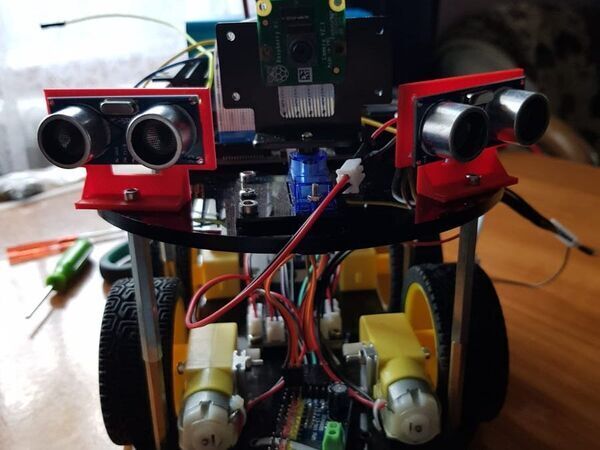
Jetson Finder: robotic car with AI & remote voice control
"Jetson car able to find objects, controlled through remote voice control using an Android Application which supports words in two languages. Jetson Finder is a robotic car powered by Nvidia Jetson Nano board, able to detect known objects, controlled through remote voice control using an Android Application which supports words in two languages: English and Romanian. It is a challenging project, because it is an interdisciplinary one, so it combines: programming on a development board to control actuators (DC & Servo motors), to get data from sensors (Ultrasonic distance sensor, Camera sensor) or to communicate (via Internet) with programming on Android and usage of a trained neural network. " [...]

A Hand-wired USB and Bluetooth Keyboard Powered by Python
"This is a hand-wired mechanical keyboard. It supports USB and Bluetooth, and is running Python in the microcontroller of the keyboard. " [...]

Touch Less Touch Switch - A touch alternative UI
"In the prevailing COVID-19 situation, introducing a touch-free User Interface for public machines to avoid community spread of the pandemic. Overview We all are now fighting against the prevailing COVID-19 pandemic. And also, now we are in a situation where we have to adapt to the prevailing conditions with more safety measures. While life coming back to normal with more safety measures to avoid virus infection, adding safety within the public places and crowded areas are also prevailing in the cities. But there were many situations where we have to break the safety measures and interact with an unsafe element to meet the needy. Here, the project is dealing with the prevention of COVID-19 spread though touch interactions or touches." [...]

TinyHVSP - High Voltage Serial Programmer based on ATtiny84
"Stand-alone High Voltage Serial Programmer and Fuse Resetter for ATtiny 13/25/45/85. " [...]
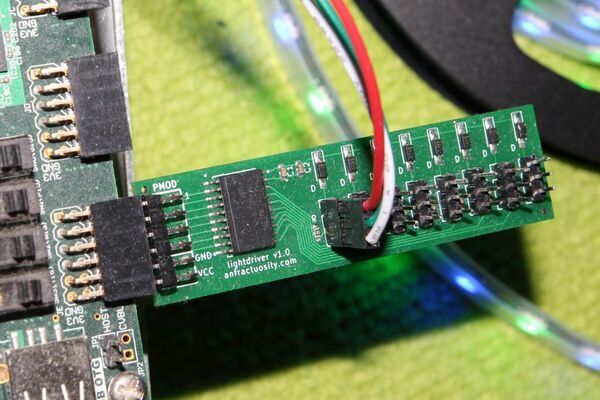
lightdriver
"I created a PMOD module PCB using KiCAD, that enables connecting WS2812B lighting strips to an FPGA board with a PMOD interface. The board was assembled by JLCPCB. This is my first project using an FPGA, I plan to soon implement an SPI interface with the FPGA, to accept colour pixels via SPI from a raspberry pi, to then drive the LEDs appropriately. I am making use of the original Zybo board which uses a Zynq FPGA, although I’m not using the ARM portion of this chip as I want to learn VHDL. I am currently making use of BRAM to store the colour data. I made use of the 74AHCT245 chip to convert PMOD signals from the FPGA from 3.3V logic to 5V logic." [...]
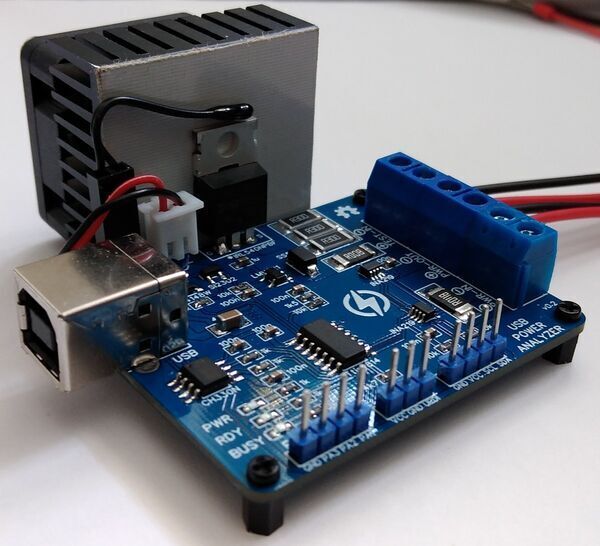
ATtiny814 Power Analyzer
"The Power Analyzer is a programmable electronic constant current dummy load with two high side voltage and current sensors for an automatic analysis of power supplys, DC/DC converters, voltage regulators, batteries, chargers, power consumers and others. The device can be controlled via USB serial interface using a serial monitor or the provided Python skripts. Data can be exported to spread sheet programs or directly be analyzed by the Python skript. The ATtiny814 controls the electronic dummy load with its internal digital to analog converter (DAC). All of its 5 internal reference voltages are being used in order to get the maximum accuracy and resolution of the DAC. The DAC is connected to an OpAmp which acts as a unity gain amplifier controlling the resistance of the MOSFET." [...]
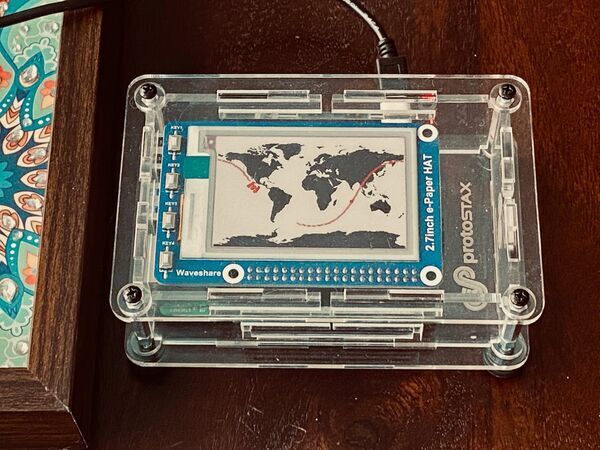
International Space Station Tracker
"Track the ISS' current location & trajectory using a Raspberry Pi, ePaper Display, ProtoStax Enclosure and Python. In this project, I show you how to track and display the current location of the International Space Station (ISS) and its trajectory over time, using a Raspberry Pi, ePaper Display, ProtoStax Enclosure and some Python. " [...]
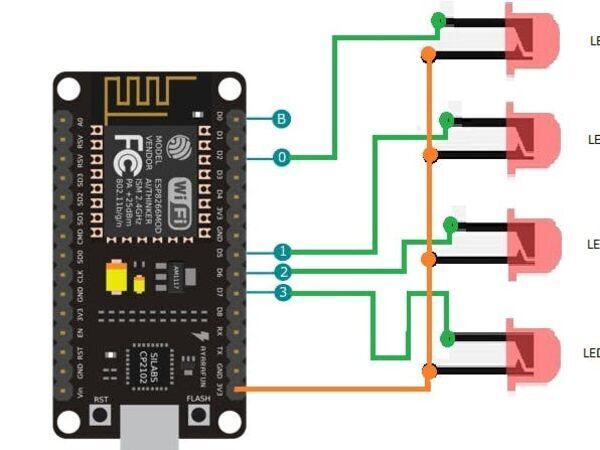
Temperature, Humidity data logger- IoT controled LED
"This is a simple data logger. Using CavyIoT service.Temperature, Humidity log is saved in CSV format in the SPIFF of NodeMCU. Which we can retrieve for later analysis. As well as the we can control LED over the internet too. " [...]

Medicine Reminder and Vending Machine
"A medicine vending machine to store and give doses via medicine bottles and alert patients at prescribed times. There is no cure for CoViD-19 yet, although patients are given some medicines by nurses and doctors to ease the pain,increase immunity, and reduce symptoms. But this puts our Healthcare warriors at risk when they give the medicine to patients, thus I developed a machine that can take in the Medicine Doses of an Entire week, store them and supply them to the patient at the time set by the doctor once, at the start-up of the machine. This will ensure distancing from patients and nurses won't have to risk their lives to go and give medicine to the infected patient. Once the medicine is on the given rack from where the patient can take it, he/she is alerted via a speaker on the system to take the medicine. The data of when the medicine is taken is stored in an SD card for further reference by doctors to monitor the effect on symptoms by the given doze." [...]
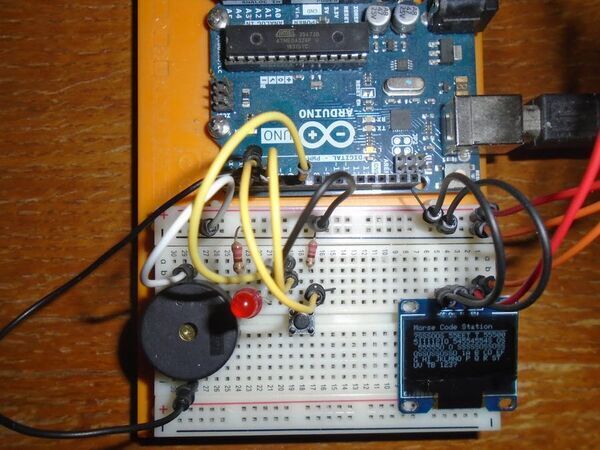
Morse Code Station
"dit-dit-dah-dah! Learn Morse Code with this easy Arduino Uno project. This easy Arduino project is a Morse Code station. Morse Code is a communication method that encodes characters as a series of dots and dashes. This circuit uses a piezo buzzer to make the dots and dashes audible. Using the button, you tap in the Morse code, the buzzer sounds with each press of the button and the OLED display shows the decoded message." [...]
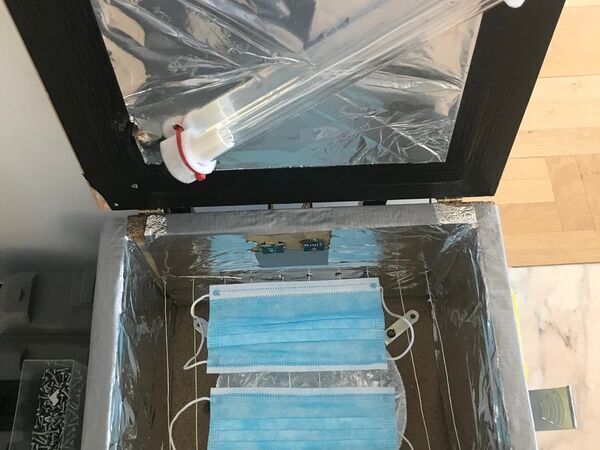
Face-Masks Disinfection Device — needlab
"UV-C / heat, Arduino-controlled, face-mask disinfecting device for Coronavirus (SARS-CoV-2). #COVID19DetectProtect FFP1 and FFP2 masks are indispensable protective elements during epidemics. They are intended for single-use, but during a crisis the re-usage is inevitable and disinfection mechanisms are required (1). During the ongoing SARS-CoV-2 pandemics, hospitals, healthcare centers, and research facilities have implemented different mechanisms of disinfection for these masks, usually involving ultraviolet germicidal irradiation (UVGI) and/or heat of some sort. Nonetheless, these methods are not available to many vulnerable parts of the population, where nonetheless, due to shortage, the re-usage of these masks has become the only option. The need for a viable method of disinfection of face masks is further increased by evidence of SARS-CoV-2 being extremely stable on the surface of surgical masks even after 7 days (2)." [...]
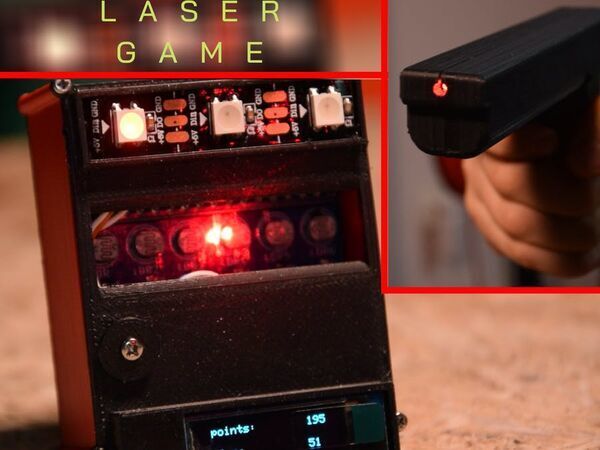
Laser Game
"I decided to build a laser gun to compete with my friends a little. As I decided I did. "Star Trek", "The Terminator", "Star Wars" or "The Avengers" - in each of these films technology was on a cosmic (literally) level. The heroes used laser weapons, which always fascinated me. I decided to build a laser gun, but I would not use it to kill people or aliens, but to compete with my friends a little. As I decided I did." [...]
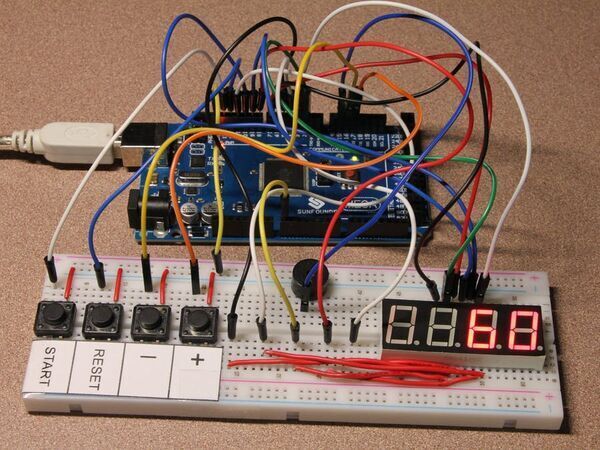
Adjustable Countdown Timer
"Adjustable countdown timer using 4-digit 7-segment display. Countdown timer is probably the most natural project for the 4-digit 7-segment display. While exploring what is available online I found several projects, but did not find the one that I had in mind, namely, a standalone adjustable countdown timer that you can conveniently adjust with the buttons (and not by uploading a modified code). So I decided to make one. I spent some time to write a code that will make it easy to use and adjust the timer, so that it can be used in practice. The included code also can be used in other projects with 4-digit 7-segment display." [...]

8x8x8 RGB LED Cube
"An animated cube made with 512 RGB LEDs driven by an ATmega328. " [...]
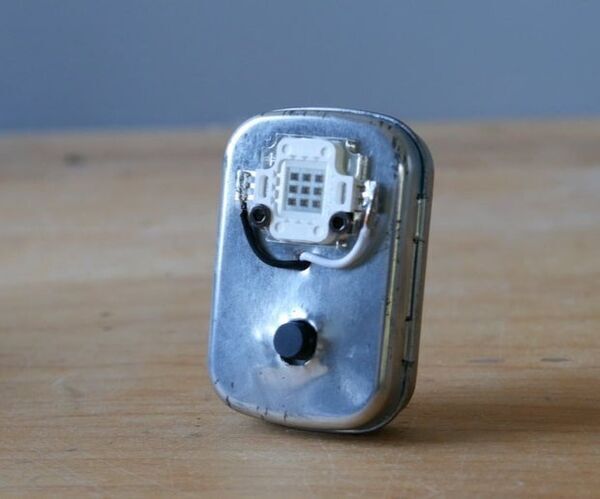
Homemade Arduino TV-B-Gone
"When I was younger I had this really cool gadget called a TV b gone Pro and it’s basically a universal remote. You can use it to turn on or off any TV in the world and it was really fun to mess with people. My friends and I would go to restaurants where lots of people would be watching TV and use the remote to turn them off. The chaos of TV's turning off suddenly was one of the funniest things to witness in person. This one broke a long time ago and I always wanted to use another one so I challenged myself to make one that was smaller, better and stronger. Instead of using the weak IR LEDs like the original." [...]

Pi-hole einkt display
"e-inkt/e-paper display that shows information about Pi-hole Hi, this is a little how-to guide for the Pi-hole e-inkt stats screen. I tried to describe everything with a lot of details, so even beginners will be able to reproduce what I made! Anyways, please let me know what you think, feedback is always welcome! I found an interesting Github page repository from BillyBunn, it is called pi-hole. (Don't confuse it with the original Pi-hole repository) Because the project of BillyBunn had some bugs that wasn't fixed. I decided to fork the repo and focussed on fixing the few bugs." [...]
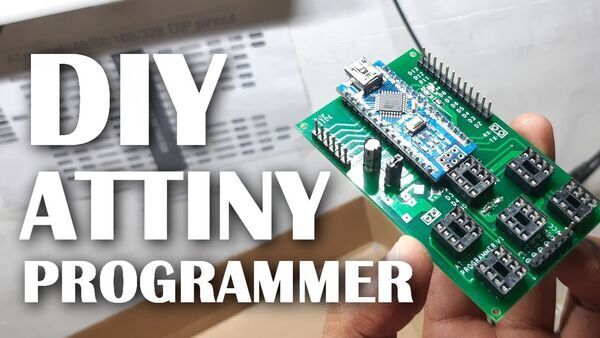
Multiple ATtiny85/13A Programmer
"Program 6 ATtiny85/13A at the same time with this custom programmer board. Attiny MCUs are very popular as it is quite easy to program them and using them instead of atmega328 chip can reduce the cost of the overall project which requires less input/outputs. so what's the next level of this above project? Designing a Programming Shield I designed this nano breakout board in OrCad Cadance, it has four LEDs (3 of them are connected to D7 D8 and D9 for ICSP programming status, and the fourth one is connected to D11 or D0 of attiny in case we need to test attiny onboard) We just need the following things for this project- Arduino nano x1 DIP8 Sockets x6 1uf 10V CAP x1 male headers 28 to be exact LEDs 0603 package x4 1K Resistor 0805 package x2 PCB 3D printed enclosure attiny85 x6" [...]

Vision Beyond the Visible with PYNQ
"We have looked at thermal imaging before however, we did that from scratch using Vivado and Software. In this project we are going to combine the FLIR Lepton with PYNQ, doing so allows me to create a PYNQ overlay that fellow lepton users can use to get started accelerating there applications without the need to worry about how to interface with the lepton sensor. This is going to be a fun project as we are going to create the following VHDL module and test bench to interface with the Lepton PYNQ Overlay to control the lepton from Python Jupyter note book to pull it all together All of these will be available for download and use from my GitHub. It will be fun as well as it is not often I write a lot of VHDL for these projects, FPGA Approach The Lepton outputs it video in a very interesting manner, it uses SPI to create something called VoSPI or video over SPI. This uses the SCLK, SS and MISO lines on a traditional SPI interface. Over this SPI link the video is transferred as in packets, there are eighty 14 bit pixels, along with a CRC and header in a packet." [...]
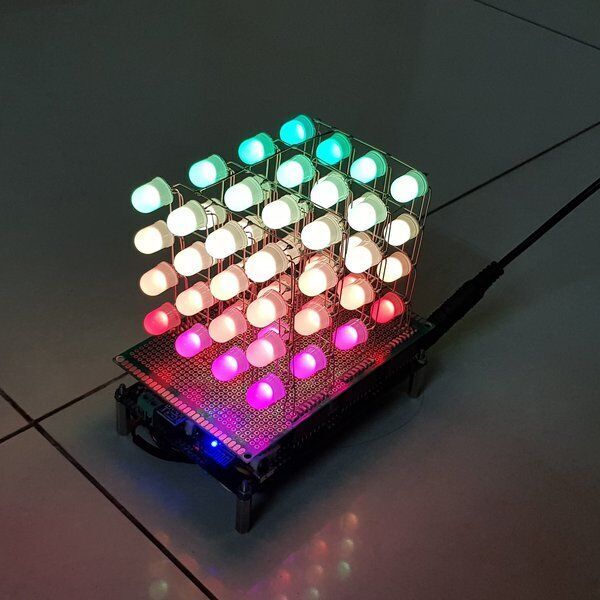
ESP-01 CONTROL RGB LED CUBE 4x4x4
"ESP-01 ESP8266 can be used as a stand-alone device to control a RGB led cube 4x4x4. Today, I'd like to share how ESP-01 ESP8266 can be used as a stand-alone device to control a RGB led cube 4x4x4 via SPI protocol & B.A.M process. My RGB led cube 4x4x4 includes 64pcs x 10mm RGB LEDs arranged in 04 x LAYERS and each LAYER arranged in 04 x ROWS and 04 x COLUMNS. 04 x LAYERS are controlled by 01pcs x 74HC595 + 04pcs x NPN Transistor 2N3904 + 04pcs x PNP Transistor TIP42C. Outputs of TIP42C are connected to LED ANODES, so the layer needs to be HIGH for an individual LED to turn on. The TIP42C can carry maximum current about 6A." [...]
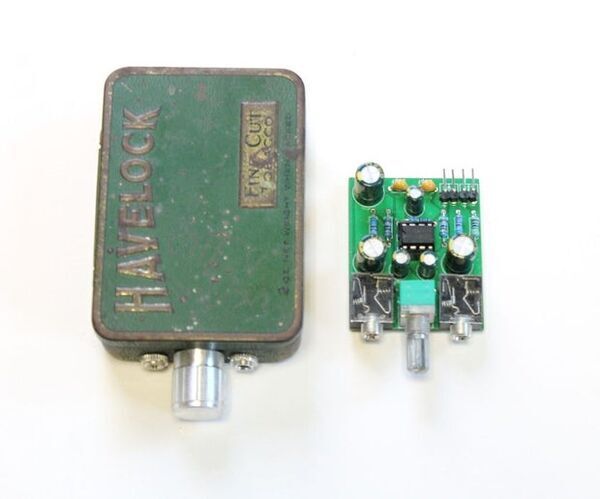
Head Phone Amp With Custom PCB
"I've been building (and trying to perfect) the headphone amp for some time now. Some of you would have seen my previous 'ible builds. For those that haven't I have linked these below. On my older builds I have always used prototype board to build the circuit. Nothing wrong with doing it this way mind you but there is more potential to make mistakes and it can be tricky trying to add all of the parts in the smallest space possible using prototype board. I thought it was time to throw myself in the deep end and start to design my own PCB's!" [...]

How to Make a DIY Smart Mirror
"A "Smart Mirror" is a two-way mirror with a display behind it that is typically used to display useful information like the time and date, the weather, your calendar, and all sorts of other things! People use them for all kinds of purposes. You'll see them placed in the bathroom, in the kitchen, as a vanity, all over the place! In this tutorial, we demystify the process of building a DIY Smart Mirror and walk you step-by-step how to make one using materials you can get online or at your local stores. Our goal is to show you that building a DIY Smart Mirror is not as hard as you might think, and to inspire you to try it! We recommend watching the video above and following along with the written steps!" [...]

DIY Bluetooth Speaker From Scratch!
"I've always wanted to make my own Bluetooth speaker from scratch and with my new found free time I decided to accelerate that want into a reality! The board I designed revolves around the XS3868 Bluetooth module and the 3watt by 3watt Pam8403 audio amp. This is all thrown together with a battery charging and voltage regulation circuit all housed inside of a project box I got off Amazon. The focus of this board was to make it as modular as possible to accommodate any type of housing for it. The end result is a pretty decent audio amp that has only one flaw and that is the Pam8403 IC. While the amp outputs a clear enjoyable sound it can be overloaded if the input volume climbs too high which will lead to a skipping sound." [...]

Li-ion Battery Bluetooth Scoreboard
"The Project is based on my Instructables from the last year: Bluetooth Table Tennis Scoreboard The Scoreboard is dedicated for amateur sport fans and table tennis player But it is not applicable just for table tennis. Can be used for other sports like Volleyball, Badminton and each sport which require points counting. By simple software change, software could be adopted to any maximal points value in match. Technical principle is based on communication via Bluetooth between Table unit (unit under table) and Scoreboard itself. Two Control Boxes are mounted under table on each player side and connected by cable to Table Unit. Player after each winning point press big touch button on Control Box." [...]
Non Contact Midi Controller
"Making things non-contact has been the trend nowadays. I created a simple midi controller using Arduino Pro micro and some IR-proximity detectors board which has an in-build comparator , this should be available fairly easy and cheap. This project can be used on any Arduino which has 32u4 based board, this was done due to the ability to use these board has MIDI without the head ache you have to go through using hairless midi and the glitches associated with it. This project was done for 7 major notes which could easily be extended for other notes. I used calkwalk by bandlab as my DAW because its cool and free. Hope you have fun making this." [...]

WiFi Enabled Matrix Lamp
"Who does not want to have stunning lamp which can display animations and sync with other lamps in the house? Right, nobody. That's why I made a custom RGB lamp. The lamp consists of 256 individual addressable LED's and all of the LED's can be controlled via a smartphone app. Additionally you can build multiple of them and make a nanoleaf like lamp (which is actually better). Supplies: Square lamp shade 16x16 LED matrix 6x4 cm PCB Esp 8266 (D1 mini) 3.3V Relay 3-pin LED connector 5V 3A PSU (more amps are possible but can lead to overheating) wires 3.3V to 5V logic level shifter Barrel jack connector wire connector (can be replaced with soldering) 2x M2 screws, washers and nuts Tools (required): soldering iron hot glue gun Tools (optional): 3D printer Files: models (for printing)" [...]

Clockception - How to Build a Clock Made From Clocks!
"Hi All! This is my submission for the 2020 First Time Author Contest! If you like this project, I'd greatly appreciate your vote :) Thanks! This instructable will guide you through the process for building a clock made of clocks! I've cleverly named it, "Clockception". I know, very original." [...]
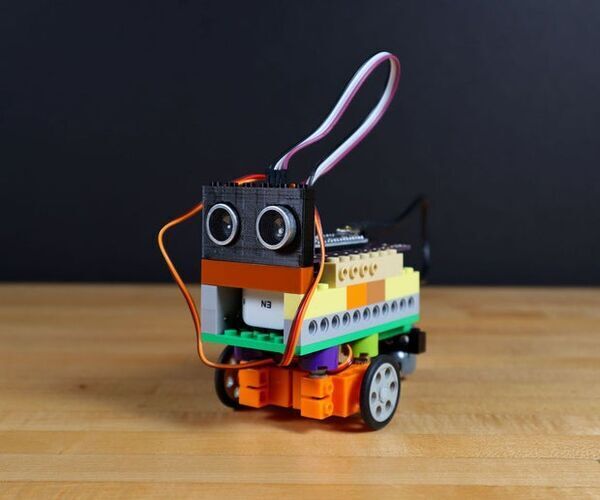
Obstacle Avoiding LEGO Robot
"We love LEGO and we also love Crazy Circuits so we wanted to combine the two into a simple and fun robot that can avoid running into walls and other objects. We'll show you how we built ours, and outline the basics needed so you can build your own. Your version might not match ours exactly, and that's okay. Below is a list of the Electronic Parts we used, and a list of the LEGO Parts we used. Your parts may vary, so don't be afraid to do your own thing. Supplies:Electronic Parts: 1 x Crazy Circuits Robotics Board 2 x LEGO Compatible Continuous Rotation 360 Degree Servo 1 x HC-SR04 Ultrasonic Distance Sensor 4 x Dupont Female to Female Wires 1 x USB Power Bank (We found a small USB Power Bank that fit into our robot nicely." [...]

The Memento Game
"You probably know those games where the player memorizes a sequence of colors and sounds and has to play them back, right? The Memento Game adds prizes for extra fun! Once a player hits a predetermined score, they win the game and the box opens, revealing the prize. I had a few requirements: the box needed to be sturdy, capable of being manhandled by a small child; the compartment had to be big enough to hold small gifts; and I wanted some way of changing the difficulty level, without allowing the players to do it themselves. Here's a video of the whole process, wherein I learn how to use Tinkercad, design the box and circuit, and then proceed to the actual build. The video skips a couple of parts and is mostly sped up 150x but don't worry, because all the actual instructions are in the next steps." [...]
Build a MIDI Controller With Arduino
"Hi everyone! In this instructable I will show you how to build your own Arduino powered MIDI controller. MIDI stands for Musical Instrument Digital Interface and it is a protocol that allows computers, musical instruments and other hardware to communicate. If you follow each and every step of this tutorial you will be able to make music with an Arduino! What you are going to learn from this Instructable: Chose the right components for this project. Sketch an interface with the right dimensions and build it." [...]
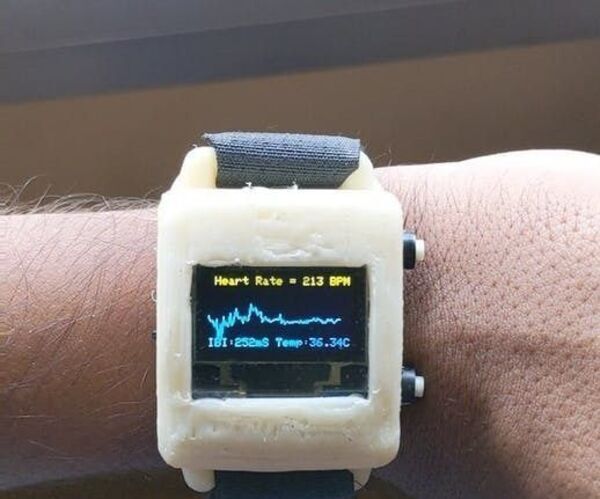
Raksha - Vitals Monitor for Frontline Workers
"Wearable health monitoring technologies, including smartwatches and fitness trackers, have attracted considerable consumer interest over the past few years. Not only has this interest has been mainly encouraged by the rapid demand growth in the wearable technology market for the ubiquitous, continuous, and pervasive monitoring of vital signs, but it has been leveraged by the state-of-the-art technological developments in sensor technology and wireless communications. The wearable technology market was valued at over $13.2 billion by the end of 2016 and its value is forecast to reach $34 billion by the end of 2020. There are many sensors for measuring vitals of the human body which are essential for a doctor or a medic to know the health problems. We all know that doctor first checks Heart Rate to know Heart Rate Variability (HRV) and body temperature. But the current wearable bands and devices fail in the accuracy and repeatability of the measured data." [...]

Contactless IoT Thermometer
"The COVID-19 pandemic has spread to most parts of the world like a wildfire. One of the most telling symptoms of the infection includes fever, dry cough, and breathlessness. Now, 95% of cases of the virus have mild symptoms that can be treated and handled at home with proper quarantine precautions. For people who have mild symptoms or are still asymptomatic but fear having been in contact with the virus, the advice given by doctors is that they need to measure their temperature at least twice a day and monitor it to help determine if they are getting better or worse. The thermometer is the most accurate way to tell if you are running a fever or not. An infrared thermometer can give you the temperature instantly." [...]
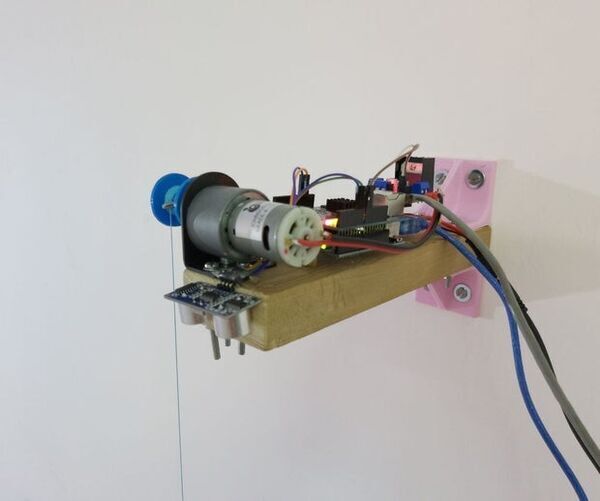
Arduino With Alexa and Google Assistant | Arduino Crane Project
"Hi everyone! Hope you like my project. The story behind the project is -- I live in a duplex apartment, which means if I need something from downstairs in my workshop, I will have to go down the stairs, and back up the stairs [ I work upstairs as the air conditioner is upstairs :) ] This gets very tiring especially in summers. I could just ask somebody from downstairs for the part I was looking for, (someone is always downstairs 75% of the time) but how will I get it back up? Hmm.... This led me to making a crane with Arduino to lift small payloads from downstairs to upstairs!" [...]
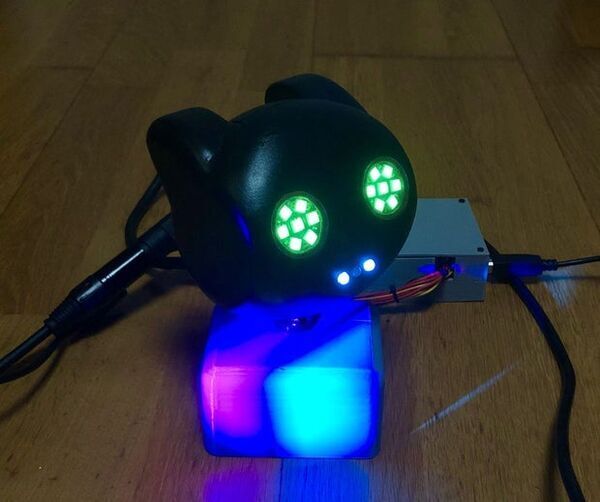
DMX Animatronic Robot
"This project describes the development of a fully functional animatronic prototype. It is implemented from scratch and it aims to be a guide for the development of future more complex animatronic robots. The system is based on an Arduino microcontroller. The communication protocol with other devices is DMX512. The choice of this communication protocol is due to the fact that it is a standard in the world of lighting technology, a common environment for this kind of robots. The developed robot includes servo motors and different types of LEDs." [...]
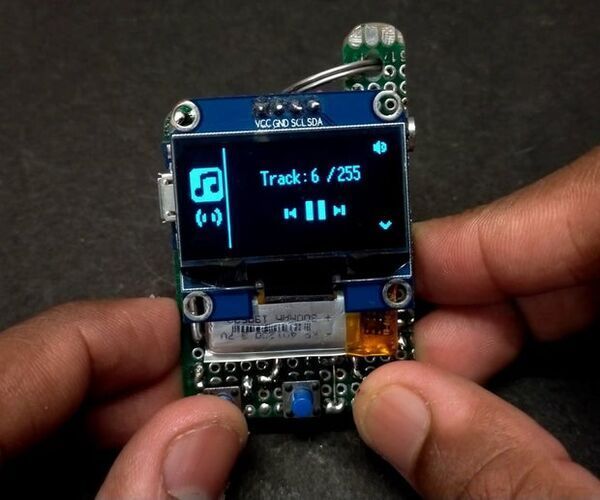
Arduino Retro Style MP3 Player!
"Mp3 player may sound quite outdated. Smartphones can do much better than this! With all those apps and streaming services, you don’t even need to download any music or song. But when I encountered the DFplayer module it really excited me with a bunch of features. From volume control, a 3W amplifier, equalizer, ability to play ads between the mp3 files, and much more. I wanted to explore all these features and put them to good use in a single device." [...]
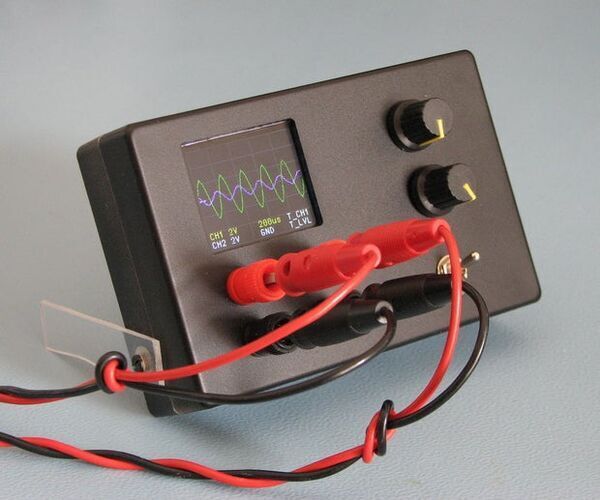
Dual Trace Oscilloscope
"When I build my previous mini oscilloscope I wanted to see how well I could make my smallest ARM microcontroller a STM32F030 (F030) perform, and it did a nice job. In one of the comments it was suggested that a "Blue Pill" with a STM32F103 (F103) might be better, smaller than the development board with the F030 and possibly even cheaper. But for the mini oscilloscope I did not use the development board but the F030 on an even smaller SMD-DIP board, so there a Blue Pill would certainly not be any smaller and I doubt that it would be cheaper too. Supplies: Part list: - plastic box - perfboard (double sided prototype board 8x12cm) - Blue Pill - ST7735s TFT display - lithium-ion battery - HT7333 3.3V low dropout regulator - MCP6L92 dual opamp - TSSOP8 to DIP8 board - 12 MHz crystal (not necessary) - rotary encoder plus knob (2x) - powerswitch - banana terminals (4x) - lithium-ion charger board - several resistors and capacitors - nylon spacers, nuts and screws Tools: - soldering station - solder 0.7mm - some wire - side cutter - glasses and loupe - drill - multimeter - oscilloscope - STLink-V2 Software: - STM32IDE - STM32CubeMX - STLink Utility - LowLayer library - adapted library for ST7735s - Notepad++ - Kicad" [...]
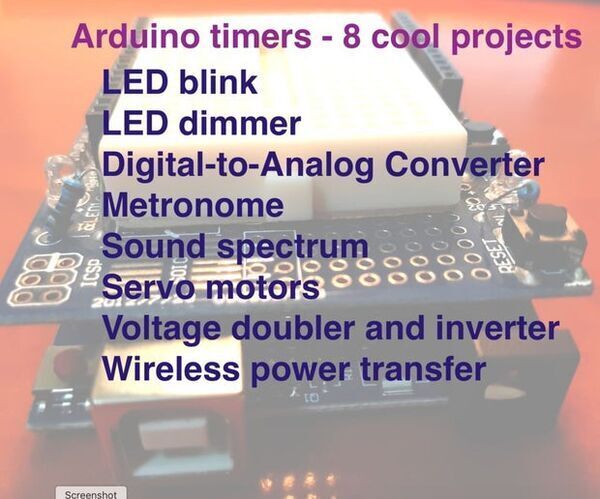
Arduino Timers: 8 Projects
"The Arduino Uno or Nano can generate accurate digital signals on six dedicated pins by using the three built-in timers. They only require a few commands to set up and use no CPU cycles to run! Using the timers can be intimidating if you start from the ATMEGA328 full datasheet, which has 90 pages dedicated to their description! Several built-in Arduino commands already use the timers, for example millis(), delay(), tone(), AnalogWrite() and the servo library. But to use their full power, youll need to set them up through the registers. I share here some macros and functions to make this easier and more transparent." [...]
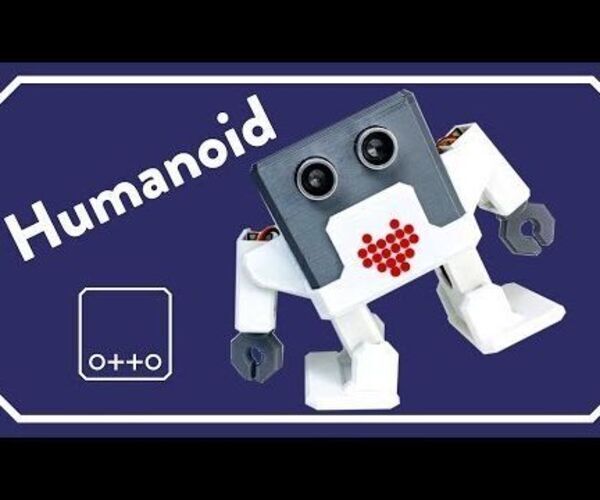
Otto DIY Humanoid Robot
"Otto bipedal robot now got arms to look similar to a "Human" and an LED matrix to express emotions. 3D print by yourself and then gather the parts to build by yourself. Otto is truly Opensource; it means the hardware is easily discerned so that others can make it, Arduino compatible, 3D printable and customizable, the perfect opportunity to build and have your very first robot, learn robotics and have fun, you will learn the logical connection between code and action, and by assembling it, you will understand how its components and electronics work. Visit www.ottodiy.com for more detailed info. Otto DIY Humanoid walks, dances, makes sounds and avoids obstacles, like the basic but also has 2 arms, one LED matrix to express emotions and a gyroscope to measure orientation and movement for interactions. Please note that Humanoid is an advanced robot compared to the simple biped Otto, it will require you to have EXPERIENCE BUILDING ROBOTS AND MORE TIME, WE RECOMMEND YOU TO FIRST BUILD THE BASIC Otto DIY AT LEAST, otherwise take it as a challenge :D Supplies:1 x Nano ATmega328 1 x Nano Shield I/O 1 x cable USB-A to Mini-USB 1 x ultrasound sensor HC-SR04 6 x Micro servo MG90s 1 x Buzzer 24 x Female/Female Jumper Wire 1 x LED Matrix 8x8 1 x sound sensor 1 x touch sensor 1 x BLE Bluetooth module 1 x charger + power booster 1 x Micro Switch Self lock On/Off 1 x Gyroscope sensor (optional) 1 x 3D printed head 1 x 3D printed body 4 x 3D printed legs (2 are the arms) 2 x 3D printed grip 2 x 3D printed foot 1 x Small Phillipis screwdriver 8 x extra M2 screws Scissors or pliers." [...]

Let's turn lights on with the computer the 433Mhz way
"A while ago I started using home assistant on a pi and bought some inexpensive 433Mhz ac wireless switches. However, after one month of intense use the Raspberry Pi didn't have enough power, so I bought a cheap computer of eBay for this purpose and it worked well expect that I didn't have control over my switches. Sure I could have use the raspberry in conjunction with the computer but that would be overkill, so I started designing an Arduino on a stick with USB and 433Mhz tx and rx. The first design I made was way too optimistic I planed to use a rf switch to switch between rx and tx and use a single sma port for the antenna but that didn't go so well and neither tx nor rx was working, so I just gave up for a few weeks and then made version two. Hardware Version two is smaller and have two coiled antennas instead of a sma port and it works well enough. It's still based around an atmega328 running at 16MHz with the Arduino UNO bootloader and a CH340 USB to Serial converter." [...]
That's all Folks!



